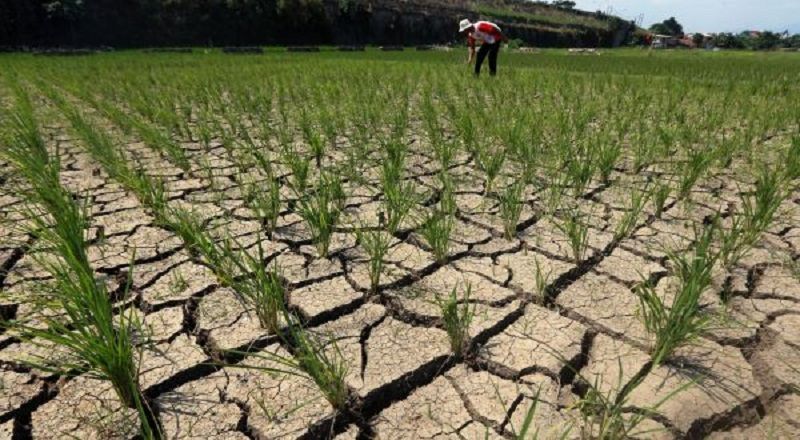Dry Season and the Threat of Decreasing Quality of Rice

Dry Season and the Threat of Decreasing Quality of Rice. Foto: Pinterest
(Istimewa)The dry season brings its own set of challenges for rice farmers. Located between Indian Ocean Region and Australia, Indonesia’s weather is strongly influenced by the wind movement between the two regions. With the dry season peaking around the month of August, where the air temperature during the day is very hot but very cold at night, the wind blowing from the aforementioned region brings dry air that lacks water vapor. Added the fact that during the dry season it no longer rains and farmers will depend a lot on dams or rivers for their water supply. These conditions affected the growth and therefore the quality of rice greatly because rice requires a large amount of water to flood the soil for its growth.
The Ministry of Agriculture has done several incentives and technological innovations to help support the agricultural sectors such as the challenges rice farmers face during the dry season. Especially considering rice being the primary food eaten by most Indonesian every day. One of those incentives is the Center for Farmers Integrated Service (SP3T) which helps farmers to manage their paddy fields. From planting seeds to the post-harvesting process such as providing them with rice mills. This helps the farmers to ensure that the rice they produce is ready to be sold. The initiative also works as a means to help collect and market farmer’s crops.
Activities of the agricultural sector during the dry season certainly can have fairly low production, however, this can be overcome with adjustment on the production process. Using the right seed helps influence the success or failure of rice production during the dry season. It is recommended to use the drought-resistance rice varieties to ensure a successful production. The Ministry of Agriculture has helped create or develop many rice variants that are suitable for natural conditions.
The high yielding variety from the variety description data that are drought-resistant or adaptive in dry soil includes the Batutegi, Situ Patenggang, Situ Bagendit, Inpago 4, Inpago 5, Inpago 7, Inpago 8, Inpago 9, Inpago 10, Inpago 11, Inpago 12, Luhur 1, Luhur 2, and Jatiluhur variety. Whereas the high yielding varieties that are adaptive in a rainfed soil are the Batutegi, Sarinah, Towuti, Dodokan, Silugonggo, Inpari 10, Inpari 11, Inpari 12, Inpari 13, Inpari 18, Inpari 19, Inpari 20, Inpari 22, Inpari 26, Inpari 27, Inpari 28, Inpari 32, Inpari 33, Inpari 38, Inpari 39, Inpari 40, Inpari 41, Inpari 42, and Inpari 43 variant. As reported from Detik Finance, The Ministry of Agriculture also recommended the Batutegi, Towuti, Inpari 10 Laeya, Inpago 4, Inpago 7, and Inpago 8 varieties for yielding fluffier rice during the dry season.
Other adjustments that can be done to ensure the production of high quality rice are the right treatment during planting such as fertilization. Take a note of the soil during the dry season. Some regions may have slightly damper soil than others depending on where it is. For drier soil, it will need more fertilizer to give the plant the nutrients it needs. Rice stages of growth also determine when to give the fertilizer. Surely each rice variant of choice will need its own set of fertilizing applications. One farmer and mill worker at Usaha Tani Rice Mill, Seno says that he prefers to plant the Inpari 42 and Inpari 32 variant during the dry season because he finds that the application of the fertilizer and pesticide are more efficient with five sprays where other plants use eight sprays. He also says that it is resistant to the kresek and the tungro disease. The varieties also produce a heavier grain that can amount up to 8 tons per hectare of dry unhulled rice. It’s no wonder that the two variants are very popular among rice farmers in Central and East Java.
The lack of water during the dry season also makes it challenging to process the harvested rice grain. Reported from Republika.co.id Yayu Rahayu, Head of Seeds, Processing and Marketing, Department of Agriculture and Food Security in Ciamis has said that during the dry season when you mill the too dry unhulled rice grain (gabah) it will result in a more broken or crumbled grain. Which in turn means less rice to sell and losses for the rice business. She suggested to avoid breaking an already too dry grain, by increasing the temperature of the drying machine gradually to yield fewer broken grains.
Dry season brings a lot of challenges for farmers and the agricultural industry in general. However, with the right planning, tending, and treatment along with the help of the government farmers can overcome the threats of lower quality and production. Using the right variant that can adjust to the natural environment, the right fertilization and pesticide, and adjusting the post-production process are just a few steps that farmers can do to overcome the challenges during the dry season.
